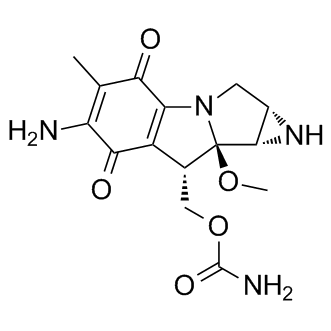| DC73188 |
QBS10072S
|
QBS10072S is a novel dual-function, BBB permeable chemotherapeutic agent with alkylating moiety and a selective large neutral amino acid transporter 1 (LAT1, SLC7A5) substrate, shows excellent BBB penetration and promising efficacy in vitro (U251 cell IC5 |
| DC46283 |
Sibiromycin
|
Sibiromycin is a naturally produced glycosylated pyrrolobenzodiazepines (PBDs). Sibiromycin is also a potent antitumor antibiotic that binds covalently to DNA in the minor groove at the NH2 of guanine. |
| DC42454 |
Treosulfan
|
Treosulfan (NSC 39069, Treosulphan) is an alkylating agent used for conventional and high-dose chemotherapy regimens. Treosulfan is potently cytotoxic against pancreatic cancer cell lines. |
| DC40328 |
PIP-199
|
PIP-199 is a selective inhibitor of RMI (RecQ-mediated genome instability protein) core complex/MM2 interaction, with an IC50 of 36 μM. MM2 is the binding site of RMI complex on Fanconi anemia complementation group M protein (FANCM). PIP-199 can be used for the research of sensitizing resistant tumors to DNA crosslinking chemotherapeutics. |
| DC40300 |
Illudin M
|
Illudin M is a cytotoxic fungal sesquiterpene that can be isolated from the culture medium of Omphalotus olearius mushrooms. Illudin M can alkylate DNA. Illudin M has anti-tumor activities. |
| DC10611 |
Trabectedin
|
Trabectedin (Ecteinascidin-743 or ET-743) is a novel antitumour agent of marine origin with potent antitumour activity both in vitro and in vivo. |
| DC5885 |
Oxaliplatin
|
Oxaliplatin is a second generation potent platinum-based anti-neoplastic agent that is believed to form inter- and intrastrand DNA adducts which activate signaling pathways culminating in apoptosis. The development of Oxaliplatin was inspired from the eff |
| DC8935 |
Mitomycin C
|
Mitomycin C is a DNA crosslinking agent that inhibits DNA synthesis and induces apoptosis in a variety of cells. |
| DC10434 |
Bisantrene
|
Bisantrene is a highly effective antitumor drug, targets eukaryotic type II topoisomerases. |
| DC11163 |
AST-3424
|
AST-3424 (OBI-3424, TH-3424) is a first-in-class, novel prodrug that selectively targets cancers overexpressing the enzyme AKR1C3, OBI-3424 is a highly selective prodrug that is converted by AKR1C3 to a DNA alkylating agent. |






















